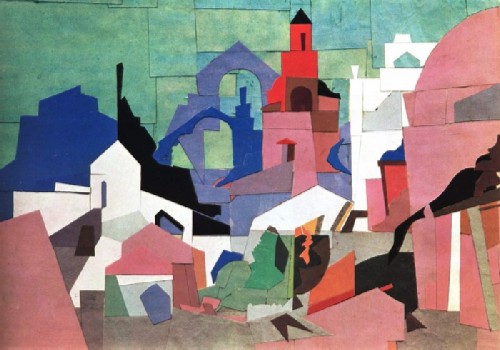
Master of avant-garde still lifes and industrial landscapes
Alexander Vasilyevich Kuprin – a significant Russian and Soviet painter of the first half of the XX century. The work of Alexander Kuprin is very diverse: it includes paintings in the spirit of Cezanneism and industrial landscapes. The biography of this artist is closely connected with the “Jack of Diamonds” association, in whose exhibitions he participated since the foundation of the society. Kuprin was also a professor at VKHUTEMAS and a member of the USSR Academy of Arts.

Biography of Alexander Kuprin
Alexander Kuprin was born on March 10, 1880 in the provincial town of Borisoglebsk in the Voronezh region. The family of the future painter was poor, but intelligent. The father taught history at the school, the mother raised the children and taught them music. Subsequently, Alexander retained an interest in this art: he composed a little and built a homemade organ in a Moscow workshop. But drawing became the main business of his life.
Alexander Kuprin was forced to engage in self-education, as there were no conditions in the provinces for the development of artistic skills. At the age of 16, after the death of his father, he had to get a job as a clerk. By that time, the family had moved to Voronezh, where a free evening drawing school with serious academic traditions was opened. Classes in it gave a lot to the future painter. Another important event was the large-scale exhibition of the Itinerants. Seeing the masterpieces of Ilya Repin, Ivan Shishkin, Isaac Levitan, Kuprin decided to move to St. Petersburg to study at the Academy.

In St. Petersburg, the life of the young artist did not work out: because of the northern climate, he was constantly ill and could not enter the Academy. After a while, he moved to Moscow. First, he took private lessons from Konstantin Yuon, then entered the Moscow School of Painting, Sculpture and Architecture, where Konstantin Korovin taught. True, classes soon had to be interrupted due to tuberculosis that developed against the background of a cold. On the recommendation of doctors, the artist moved to Yalta for a year, and since then the theme of the Crimean nature has remained in his work for the rest of his life.

After returning to Moscow
After returning to Moscow, Kuprin noticed that innovative ideas from the West were increasingly penetrating art. Young artists visited the galleries of Sergei Shchukin and Ivan Morozov, where they got acquainted with the works of the Impressionists, Post-Impressionists and Cubists. Alexander Kuprin compared the painting of Claude Monet, Paul Cezanne, Vincent Van Gogh and Henri Matisse to a stream of crystal-clear water that inspires the soul and inspires hope. I had to leave the school because of disagreements with the teachers, but during this period the “Jack of Diamonds” society was born.
Alexander Kuprin was a member of the new association from the very beginning. He strove to create a vivid and expressive painting with a free and energetic manner of painting. Many participants in Jack of Diamonds willingly turned to still life, and for Kuprin this genre became one of his favorites. At first, the painter fell under the influence of Mikhail Larionov, and after a year’s trip to Europe he became interested in the ideas of post-impressionism and cubism. During that period, many of the artist’s best works were written, which made him famous.

After the revolution Kuprin became a teacher at VKHUTEMAS.
When such schools began to open in provincial cities, he volunteered to go to Nizhny Novgorod and spent two years there. In the early 1920s, like other members of the Jack of Diamonds, he abandoned the avant-garde and switched to realistic painting. Many wonderful Crimean landscapes were painted then. In the 1930s, the artist turned to the industrial theme: he painted Moscow factories, coal deposits of Donbass and oil fields of Azerbaijan. Alexander Kuprin lived for 79 years and continued to write until recently. At the age of 77, he received a personal exhibition in Moscow. The artist died on March 18, 1960.

The most famous paintings by Alexander Kuprin
The life of this painter was long and fruitful. He created many outstanding and diverse works, among which there are examples of both traditional and avant-garde painting. Here are some famous paintings by Alexander Kuprin:
- Lying Nude (1917). Although the painting depicts a nude, the composition is built like a still life with fruits and utensils surrounding the woman.
- “Still life with a sculpture of Boris Korolyov” (1919). The artist more often painted not flowers, but objects created by man, which he depicted with bright contrasting colors.
- Donbass. Coke and gas plant. Station Khanzhonskaya “(1934). The industrial landscape is a realistic genre, but here Kuprin also finds a place for unusual shades and expressive angles.
- “Crimea. Evening in the vicinity of Bakhchisarai “(1936). The Crimean landscapes of this author are distinguished by their lyrical mood and softness of colors. They reveal the theme of harmony between nature and man.

Currently, many of Alexander Kuprin’s works are kept in the Tretyakov Gallery, the Russian State Museum and numerous regional collections. Also, his work is in demand at auctions. In 2014, the painting “Twilight Landscape. Churuk-Su River, Bakhchisarai ”was sold for $ 317,000. Before that, the work of “Topol” went under the hammer for 176,000 dollars.







